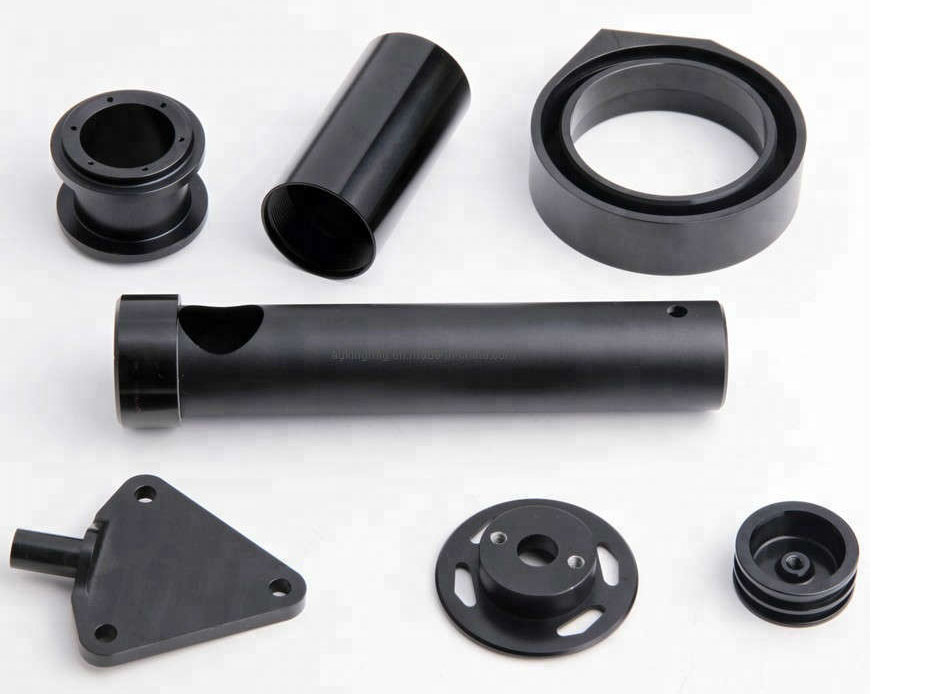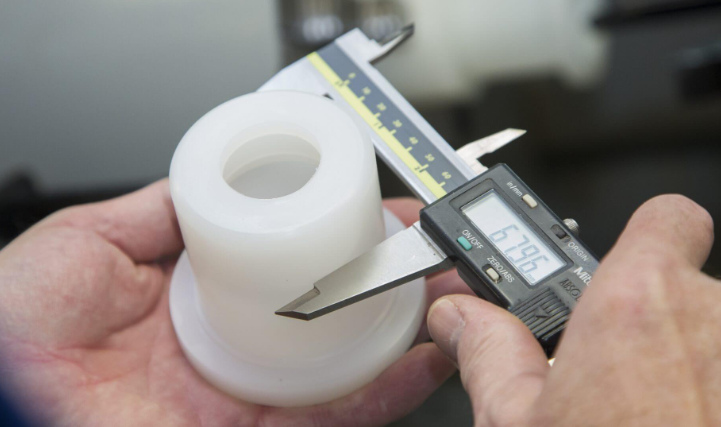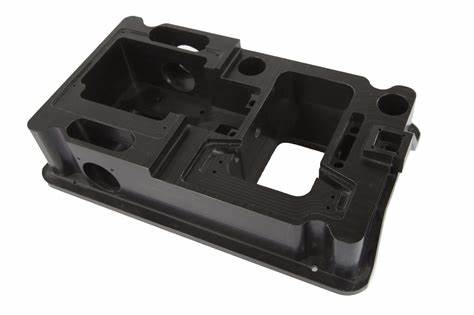
In the mechanical parts processing industry, plastic is a very common material, and machining is a common processing process. Which plastics are suitable for machining?
1、ABS
ABS is one of five synthetic resins with excellent impact resistance, heat resistance, low temperature resistance, chemical resistance and electrical properties. It is characterized by easy processing, stable product size, good surface gloss, easy painting and coloring. It can also be used for surface coating metal, electroplating, welding, hot pressing, bonding and other secondary processing. Thermoplastic engineering plastics are widely used in mechanical, automotive, electronic, instrumentation, textile, construction and other industrial fields. ABS is usually light yellow or milky white granular amorphous resin, which is one of the most widely used engineering plastics.
2. Nylon PA6
PA6 material has quite high comprehensive properties, including mechanical strength, stiffness, toughness, mechanical damping and wear resistance. These characteristics, together with good electrical insulation and chemical resistance, make PA6 a "universal" material for the production of mechanical structural parts and maintenance parts.
3. Nylon PA66
Compared with PA6, PA66 has more excellent mechanical strength, stiffness, heat resistance, wear resistance and creep resistance, but its impact strength and mechanical damping performance are lower, which is suitable for automatic lathe processing. PA66 is widely used in the automotive industry, instrument housings and other products requiring impact resistance and high strength.
4. Nylon PA12
The scientific name of PA12 is polybutylamide, which is a semi-crystalline crystalline thermoplastic material. Its characteristics are similar to PA11, but its crystal structure is different. PA12 is a good electrical insulator. Like other polyamides, it is not affected by the influence of moisture on the insulation performance. It has excellent impact resistance and mechanical and chemical stability. PA12 has many improved varieties in terms of plasticization and performance improvement. Compared with PA6 and PA66, the melting point and density of these materials are lower and the return rate is very high. PA12 has no resistance to strong oxidation. Typical application scope of nylon 12: commercial equipment, such as water meter, cable sleeve, mechanical cam, sliding mechanism, photovoltaic backplane and bearing.
5. PVC
Polyvinyl chloride (PVC), peroxide and vinyl chloride monomers polymerize under the action of light and heat according to the mechanism of radical polymerization in the promoter of azo compounds or analogues (VCM). Vinyl chloride homopolymer and vinyl chloride copolymer are collectively referred to as vinyl chloride resin. PVC was once the most common plastic in the world and was widely used. It is widely used in building materials, industrial products, daily necessities, floor leather, ceramic tiles, artificial leather, pipes, wires and cables, packaging films, bottles, foaming materials, sealing materials, fibers, etc.
6、POM
POM is a tough and elastic material, which has good creep resistance, geometric stability and impact resistance even at low temperature. POM has homopolymer and copolymer materials. Homopolymer materials have good ductility and fatigue strength, but are difficult to process. The copolymer material has good thermal stability, chemical stability and convenient processing. Both homopolymer and copolymer materials are crystalline materials, which are difficult to absorb water. The high crystallinity of POM leads to very high shrinkage, which can reach 2% to 3.5%. Different steel bars have different shrinkage rates. POM has extremely low friction coefficient and good geometric stability, especially suitable for the manufacturing of gears and bearings. Due to its high temperature resistance, pipeline equipment (valves, pump boxes) are also used for lawn equipment. Materials for making toys, such as video camera, CD, LD, MD player, radio, headset, stereo, OA equipment and other audio equipment, printer, keyboard, CD-ROM drive, washing machine, dryer, dryer, auto parts, such as mechanical parts of safety belt, door handle, mirror, engine room, camera, watch, building materials and other precision parts, game machine and stationery.

7. PMMA acrylic acid
Polymethyl methacrylate is a popular name, called PMMA for short. The chemical name of polymer transparent material is polymethacrylate, which is a polymer compound of polymethacrylate. An important thermoplastic developed in the early stage. Organic glass is divided into colorless transparent, colored transparent, pearl light and embossed organic glass. PMMA is commonly referred to as acrylic acid, middle eave acrylic acid and acrylic acid. PMMA has the advantages of good transparency, good chemical stability, good mechanical properties, good weather resistance, easy dyeing, easy processing and beautiful appearance. Organic glass is also known as gelatin glass, acrylic glass, etc. This material is widely used in the production of advertising light boxes, nameplates, etc.
8、PC
Polycarbonate (PC for short) is a polymer containing carbonates in the molecular chain. According to the structure of ester group, it can be divided into fat, aroma, fat aroma, etc. Fatty and aliphatic aromatic polycarbonates are limited in engineering plastics due to their low mechanical properties. The three main application fields of PC engineering plastics are glass assembly industry, automobile industry, electronic and electrical industry, followed by industrial machinery parts, optical disk, packaging, computer and other office equipment, medical and health care, film, leisure protection equipment, etc.
9. Polypropylene
Polypropylene is a thermoplastic resin made by polymerizing propylene. The relative density is only 0.89-0.91, which is one of the lightest plastics. Due to its high crystallinity, the material has good surface hardness and scratch resistance. PP has no environmental stress crack problem.
10、PPS
PPS plastic (polyphenylene sulfide) is a thermoplastic special process plastic with excellent overall performance. Its outstanding characteristics are high temperature resistance, corrosion resistance and excellent mechanical properties. Electrical insulation (especially high-frequency insulation) is excellent, white is easy to crack hard, there is metal sound when landing, the light transmittance is second only to plexiglass, water resistance is good, and chemical stability is good. It is a kind of plastic with excellent flame retardancy and non-flammability. It has general strength and good rigidity, but its quality is fragile, it is easy to occur stress embrittlement, and it is vulnerable to benzene, gasoline and other organic solvents. Its long-term use temperature can reach 260 ° C, and it is stable at 400 ° C in air or nitrogen. The impact strength, heat resistance and other mechanical properties can be significantly improved by adding glass fiber and other reinforcing materials. The density increases from 1.6 to 1.9, and the molding shrinkage is less than 0.15-0.25%. It is applicable to the manufacture of heat-resistant parts, insulating parts, chemical equipment, optical equipment and other parts.
11、PEEK
Polyether ether ketone (PEEK) resin is a special engineering plastic with excellent properties. Compared with other special engineering plastics, it has high temperature resistance of 260 ℃, good mechanical properties, good self-lubrication, strong chemical corrosion resistance, strong flame resistance, strong peel resistance, strong wear resistance, nitric acid, concentrated sulfuric acid, radiation resistance, corrosion resistance, corrosion resistance, and ultra-mechanical properties, which can be used in high-end machinery, nuclear engineering, aviation and other technologies.

12. Teflon
Polytetrafluoroethylene (PTFE) (commonly known as "the king of plastics, Hara"), trademark Teflon ®, The pronunciation of the trademark "Teflon" in China is also known as "Teflon", "Teflon", "Teflon", "Teflon", etc. These are transliterations of "Teflon". The product of this material is often referred to as "non adhesive coating". A synthetic polymer material in which all hydrogen atoms in polyethylene are replaced by fluorine. The material is acid-resistant, alkali-resistant, resistant to various organic solvents, and almost insoluble in all solvents. At the same time, polytetrafluoroethylene has the characteristics of high temperature resistance. Because of its extremely low friction coefficient, it can be used as a lubrication method and also as an ideal coating, which does not adhere to the inner layer of the boiler or water pipe.
13. Polyurethane PU
Polyurethane is a polymer with - NHCOO - repetitive structural unit in the main chain, referred to as PU, including rigid polyurethane plastic, soft polyurethane plastic, polyurethane elastomer and other forms, which are divided into thermoplastic and thermosetting. Raw materials are usually in resin state.
14、PET
Polyurethane is a polymer with - NHCOO - repetitive structural unit in the main chain, referred to as PU, including rigid polyurethane plastic, soft polyurethane plastic, polyurethane elastomer and other forms, which are divided into thermoplastic and thermosetting. This is produced by the exchange of dimethyl terephthalate and ethylene glycol ester or the esterification of ethylene glycol terephthalate. First, p-xylene hydroxyethyl ester is synthesized, and then polycondensation is carried out. Together with PBT, it is called thermoplastic polyester or saturated polyester. It has excellent physical and mechanical properties in a wide temperature range. Long-term use temperature can reach 120 ° C. It has excellent electrical insulation performance. Even at high temperature and high frequency, the electrical performance is good, but the corona resistance is poor, creep resistance, fatigue resistance, friction resistance and dimensional stability are good.
Thanks for reading.
Read more: [HOT] The Things You Need To Know About CNC Machining

